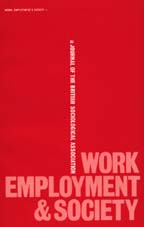Article contents
THE MYTH OF EMPOWERMENT: WORK ORGANISATION, HIERARCHY AND EMPLOYEE AUTONOMY IN CONTEMPORARY AUSTRALIAN WORKPLACES
Published online by Cambridge University Press: 01 March 1999
Abstract
The aim of this paper is to assess the validity of the ‘empowerment thesis’: the belief that new forms of work organisation are overturning traditional managerial structures and returning control to employees. Specifically, the project seeks to explore the role of ‘empowering’ forms of work organisation (in particular Total Quality Management, team-based work and consultative committees) and of occupational hierarchies, respectively, in influencing levels of employee autonomy. Data from the 1995 Australian Workplace Industrial Relations Survey (AWIRS95) are used to construct quantitative indicators of ‘empowering’ forms of work organisation, hierarchy and employee autonomy. Associations between the variables are measured. The analysis shows no association between ‘empowerment’ and employee autonomy. There are, however, clear relationships between employees' positions within occupational hierarchies and their levels of control over their work. Therefore, the empowerment thesis is rejected. A provisional explanation for the failure of empowerment to enhance employee autonomy can be found in the fact that organisational power resides primarily in organisational structures. Contrary to claims of the emergence of the ‘post-bureaucratic organisation’, hierarchical structures remain central to the majority of contemporary organisations, and the impact of other changes to work organisation must be understood in this context.
- Type
- Research Article
- Information
- Copyright
- 1999 BSA Publications Ltd
- 92
- Cited by




